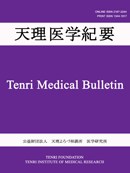Volume 12, Issue 1
Displaying 1-10 of 10 articles from this issue
- |<
- <
- 1
- >
- >|
Special Article
-
Article type: Special Article
2009 Volume 12 Issue 1 Pages 1-18
Published: December 25, 2009
Released on J-STAGE: April 15, 2022
Download PDF (31649K)
Original Article
-
Article type: Original Article
2009 Volume 12 Issue 1 Pages 19-32
Published: December 25, 2009
Released on J-STAGE: April 15, 2022
Download PDF (560K) -
Article type: Original Article
2009 Volume 12 Issue 1 Pages 33-41
Published: December 25, 2009
Released on J-STAGE: April 15, 2022
Download PDF (440K) -
Article type: Original Article
2009 Volume 12 Issue 1 Pages 42-51
Published: December 25, 2009
Released on J-STAGE: April 15, 2022
Download PDF (6740K) -
Article type: Original Article
2009 Volume 12 Issue 1 Pages 52-60
Published: December 25, 2009
Released on J-STAGE: April 15, 2022
Download PDF (777K)
Case Report
-
Article type: Case Report
2009 Volume 12 Issue 1 Pages 61-67
Published: December 25, 2009
Released on J-STAGE: April 15, 2022
Download PDF (372K) -
Article type: Case Report
2009 Volume 12 Issue 1 Pages 68-74
Published: December 25, 2009
Released on J-STAGE: April 15, 2022
Download PDF (10180K) -
Article type: Case Report
2009 Volume 12 Issue 1 Pages 75-81
Published: December 25, 2009
Released on J-STAGE: April 15, 2022
Download PDF (3061K)
Featured Papers of Departments(2008)
-
2009 Volume 12 Issue 1 Pages 82-92
Published: December 25, 2009
Released on J-STAGE: April 15, 2022
Download PDF (633K)
2008 Symposium Organized by Tenri Institute of Medical Research
-
2009 Volume 12 Issue 1 Pages 93
Published: December 25, 2009
Released on J-STAGE: April 15, 2022
Download PDF (395K)
- |<
- <
- 1
- >
- >|
